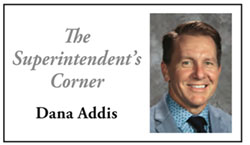Superintendent’s Corner
In January, Governor Mike DeWine discussed the science of reading in his annual State of the State address. Since then, you’ve probably heard more about the governor visiting school districts to meet with students and teachers, and to observe their reading lessons firsthand. In fact, DeWine’s proposedbudget includes $129 million for science of reading curricula and professional development on reading instruction for educators.
In the 2019-2020 school year, Hudson City Schools implemented new literacy resources for kindergarten through 3rd grade. They were Teachers College-Lucy Calkins “Reading Units of Study” published by Heinenmann and Classroom Supplemental Resources with Fountas and Pinnell published by Heinenmann. In addition, the district was further reviewing phonics resources in the Fall of 2019 in order to build upon the literacy instruction. We added Teachers College phonics for all students and “Fundations” phonics as an intervention tool for students who needed additional practice. Phonics has always been part of the Hudson City School’s literacy programming.
It is important to note that these curriculum decisions were made with elementary teacher input within our district. These resources were also displayed at the Hudson Public Library and announced to our community so they could see/read what the district planned to adopt.
Since the adoption of the K-3 reading textbook, we have continued to add resources that build up our phonics instruction, including:
- Piloting the 2022 revisions of Teachers College-Lucy Calkins, which migrates away from what is called the “cueing system” to using phonics first when reading or decoding words. The revisions are aligned to the science of reading.
- Piloting “Fundations” (a Wilson resource), a phonics program in our elementary buildings as a whole class instructional program and not just at the intervention level.
- Working for the past year to adjust our curriculum, namely increased phonics identified in the dyslexia law that aligned with Ohio’s Plan to Raise Literacy Achievement.
- Adding professional development for staff to learn how to best utilize these resources and adjust their instruction to meet the needs of our students.
The district believes literacy and teaching young students to read is one of most important tasks we have as educators. Our training reinforces the professional flexibility and judgment of our teachers so they are able to meet the diverse needs of our students. We want our teachers to have a large repertoire of instructional options. In addition, we continue to welcome thoughts and input from our stakeholders as we constantly strive to do what is best for our students.
Educators realize more than ever before that students have different needs, especially when it involves learning to read. We continue to analyze and adjust our practices to address these needs. Most importantly, the district is committed to helping every child succeed. ∞

